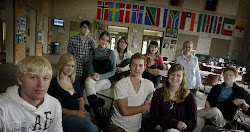The first thing I noticed when arriving in Sweden is that the people are very nice and welcoming. We've had many opportunities to sit with strangers on trains and buses and they are always willing to talk and get to know you. Once I got to sit with this Swedish girl and after a few minutes of being on the train she was playing cards with myself and two other SESEF delegates. We then learned that she was on her way to the airport heading for Austria and then on to northern Italy where she was to work as a ski instructor for a few months. These types of experiences as well as interactions with my host family and friends as well as strangers on the street, have contributed to my overall impression of their general hospitality.
2. Candy the Crazed Obsession.
I haven't met one Swedish person yet who does not like candy, nor have I gone a day without some kind of sweet or chocolate. One day I got by with only having one piece of chocolate but when I arrived home my host father was prepared with three dishes filled with swedish gummies and licorice along with three boxes filled with Marzipan covered in chocolate and, to top it off, a bowl filled with chocolate bars. When you walk into any grocery, movie rental or convenience store there is always a HUGE wall of what they call "loose candies" and all of the candies are at one price to make it even easier to purchase. Candy as a common treat, not even mentioning the wonderful and delicious variety, definitely stands out as a necessity in Swedish culture.
3. Healthy Eaters.
Although they love their candy, Swedish people also prize healthy food and hold their health to an extreme importance. In my host family's home there is not even a microwave because they fear it will be a temptation to eat more conveniently and not cook every meal. Their refrigerator is always stocked with vegetables and a multiple assortment of fine cheese and pork products along with other, more organic foods, and their cupboards are stocked with teas and large assortments of flat and leavened multi grain breads. I have also noticed that they tend to eat in smaller portions multiple times a day and whenever they are hungry instead of grabbing the not commonly seen bag of chips or soda. They are more likely to grab a thin slice of flat bread, a slice of Christmas ham and make a "sandwich" with mustard on top (an example of a type of healthy snack my family eats often). As a side note, it is not common to see a fast food restaurant in the cities. Usually there is one or two in train stations, and a few more in malls and airports.
4. Public Transportation.
In Sweden there are two ways that teenagers and many adults get around town, walking/biking, or public transportation. Due to the layout of the cities, especially Landskrona, walking and biking to your friends house or the store is the number one used means of transportation. At all times are people on the sides of the road, even when the weather seems unbearably cold. They even have a separate sidewalk of sorts for bikers because it is so commonly used. So biking and walking are the number one means of transportation to get around the town, however if one needs to travel to another city it is most common to use public transportation. From my observation, I would even go as far to say that more people take the train then drive. It is cheap and very efficient, with few (if any) layovers in other cities. The train system is also very cheap and accommodates all kinds of people, with passenger cars designated for animals, and talking, as well as standing sections for train hoppers, large seated cars for first class business travelers, and silent train cars for the common book worm or sleep deprived student. The bus system is also very effective with four or five different routes throughout Landskrona. There is a bus at every stop every 7-10 minutes during busy times and usually a bus is waiting at the train station when a train pulls in on time. Most families only have one car, maybe two out in the country, so this also helps drive up the number of people who are dependent on the public transportation system.
5. Spatial Conscience.
In the cities, space is very crucial, and not many people own large homes. In my home every room is used everyday and has purposeful uses. On the main floor there is one family room where the family gathers and watches TV, a kitchen and dining area where all meals are cooked (this is the center of the home), and a small closet they call a bathroom. Upstairs there are two bedrooms and a small sitting area at the top of the stairs for a study. There is also one small community bathroom with the only shower in the home. Underneath the house is a small basement with a living room to watch movies (the teenager hang out spot) that is connected to a laundry room and a small office (aka my room for the time being) and one other bedroom. The square footage of the house is small and the house is connected to many other homes, yet it seems so full because every inch of the space is used effectively. Another home I visited had a similar layout. It was only when I visited the countryside that I saw larger homes, but even then they are used to the maximum effectiveness. In one of the country houses I visited they split the house. One half was for living purposes and the other side was their home run store for interior decorating. Another example of being space conscience was when my host father was looking in the local newspaper and saw a home had been newly built and was very skinny. It had been built where an ally between to buildings had been and was selling for a few million krona. Space is very important to the Swedish. Like we learned at the architecture exhibit, we need to build up to accommodate for our population, and that is exactly what they do.



No comments:
Post a Comment